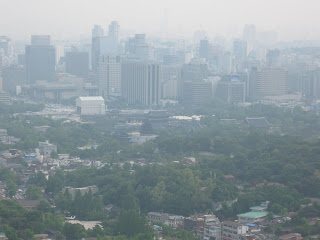Musical Chairs Mayhem
Touchdown Dance
Photo Finish
Sadly, two weeks ago Dominic enrolled at an international school (he was born in the US, so he has dual citizenship), thus he is no longer in my class. When I heard he was leaving I knew I had to capture a game of musical chairs on video. It is the kids' favorite game and when we play the stakes are pretty high. The winner takes home a GDA sticker, which, in the eyes of a six year-old, is priceless. I decided to provide some highlights for your viewing pleasure, along with in-depth analysis. In this post I'll put on my sportscaster hat and attempt to dissect some of footage and provide background on some of the top players.
Dominic Taunts
Dominic Taunts
Part of what makes Dominic a strong musical chairs contender is his ability to get inside the head of other players, flustering them and giving him the psychological edge. Throughout this video you can hear Dominic talking smack to Eena in Korean. This makes it hard for Eena to focus on her game plan. This video also contains Dominic's classic "Thinker" move. I'm not sure if it's meant intimidate opponents or distract them, but it seems to work quite effectively. It's moves like this that make Dominic a perennial contender whenever we play musical chairs
Touchdown Dance
While clearly a talented player, Dominic takes many risks throughout the course of the game. "The crawl" is perhaps the most salient example of such risky play. You may also have noticed that Dominic has perfected the art of the "touchdown dance," which he employs before sitting down when he knows that his opponents can no longer reach him.
Dominic's top two adversaries are Justin and Harry, both of whom feature a more cool-headed approach to the game. Justin is the classic Steve Yzerman-type player. He follows the rules of the game and succeeds through his hard work and dedication to the sport. Harry is a very sly player, and knows how to push the rules and bend them to his favor. He knows when the ref is watching closely (and when he's focused on filming). Harry is the player that walks around putting his hand on each chair, taking advantage of the poor officiating. Both players are forces to be reckoned with and highly competitive. They have yet to finish out of the top three, which is quite a feat. Despite being extremely friendly off the court, Harry takes it personally when he loses, and often appears dejected for the remainder of the class. Harry lives the words of the great Vince Lombardi: "Winning isn't everything it's the only thing."
Dominic's top two adversaries are Justin and Harry, both of whom feature a more cool-headed approach to the game. Justin is the classic Steve Yzerman-type player. He follows the rules of the game and succeeds through his hard work and dedication to the sport. Harry is a very sly player, and knows how to push the rules and bend them to his favor. He knows when the ref is watching closely (and when he's focused on filming). Harry is the player that walks around putting his hand on each chair, taking advantage of the poor officiating. Both players are forces to be reckoned with and highly competitive. They have yet to finish out of the top three, which is quite a feat. Despite being extremely friendly off the court, Harry takes it personally when he loses, and often appears dejected for the remainder of the class. Harry lives the words of the great Vince Lombardi: "Winning isn't everything it's the only thing."
Photo Finish
In this final clip, Dominic's risky style of play catches up to him. "The Crawl Move" fails, and Dominic finds himself in a heated battle for the last chair. While Dominic has a huge upside, his fundamentals clearly need improvement. Unfortunately, musical chairs officiating does not make use of instant reply. If I remember correctly, the referee invoked Article III, Section 2 of the rule book and called for a do-over. After re-watching the highlight, I think the ref got it right. While Dominic has the required two cheeks down, he clearly pushes off.













